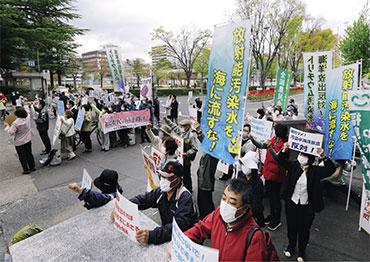In contrast to the opposition of neighboring countries and environmental groups, the US appears to back Japan’s plan. Following Japan’s initial announcement on April 11, 2021, high-level US officials rushed to applaud the decision.
US Secretary of State Antony Blinken tweeted on April 13, 2021 that “we thank Japan for its transparent efforts in its decision to dispose of the treated water from the Fukushima Daiichi site.”
On April 18, 2021, US Envoy for Climate John Kerry told South Korean media that the US is confident that “Japan has weighed all the options and the effects” and has been “transparent about the decision and the process.”
Japan’s plan was endorsed by Rafael Mariano Grossi, director general of the International Atomic Energy Agency (IAEA). The same day Blinken thanked Japan for its decision, Grossi made a statement that called Japan’s decision a “milestone” that will help pave the way for decommissioning the Fukushima plant. It is “technically feasible and in line with international practice,” Grossi said.
The IAEA later formed a task force and released three reports. But it has not yet completed its assessment or drawn specific conclusions on Japan’s disposal plan.
Most Western countries have been quiet on the issue. On February 22, The Japan Times reported that Tokyo will seek the endorsement of G7 countries when it hosts a meeting of the group’s energy ministers in April.
Citing an unnamed source inside the Japanese government, the report said Tokyo is seeking to include a phrase that says G7 members “welcome” its “transparent” approach toward the disposal plan in a joint statement to be released after the gathering in Sapporo, Japan in mid-April. The report said that some G7 countries are against such a statement.
It remains unclear whether G7 countries will openly support Japan’s disposal plan as a group. But it appears that Japan has the backing of the US, Britain and France.
All three countries supported Japan when Tokyo blocked a proposal for international scientific assessment of alternatives to discharging the Fukushima radioactive water at a meeting of the UN International Maritime Organization (IMO) in October 2021.
These three countries are also the three nuclear powers of the G7, all of which have a long history of contaminating the ocean with nuclear materials. Between the 1940s and 1990s, these countries conducted several hundred nuclear tests in the South Pacific that caused serious contamination.
For many analysts in China, Washington’s vocal support and the relatively blanket silence from the West over the issue stems from geopolitical considerations as the US seeks to strengthen its military ties to counter China.
Citing Chinese experts, an article published by Chinese State-media outlet the Global Times on April 13, 2021 described the US’s backing of Japan’s plan as a “political deal” in exchange for Japan’s closer strategic adherence.
Japan’s announcement that it will release the nuclear wastewater came just two days after Japan signed a military pact with the UK and upgraded its security alliance with the US.
As Japan’s dumping of nuclear wastewater appears to be imminent, outrage is growing among regional countries, especially in the South Pacific, a region with a long history of being used as the world’s nuclear waste dumping ground.
Motarilavoa Hilda Lini, a prominent politician and activist in Vanuatu, said: “We need to remind Japan and other nuclear states of our Nuclear Free and Independent Pacific movement slogan: ‘If it’s safe, dump it in Tokyo, test it in Paris and store it in Washington, but keep our Pacific nuclear-free.’”
In an op-ed for the Guardian on January 4, 2023, Henry Puna, Secretary General of the PIF, called on Japan to hold off on any disposal plans.
“The decision for any ocean release is not and should not only be a domestic matter for Japan, but a global and transnational issue,” Puna wrote.
He called on Japan to work with regional countries to find a solution. “Our collective future and that of our future generations depends on it,” he added.

 Old Version
Old Version

